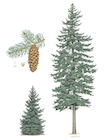
Illustration of tree, seed cone, seeds, and foliage [Matt Strieby, 2022].
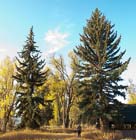
Two mature trees in habitat at Menor's Ferry, Grand Teton National Park, WY [C.J. Earle, 2012.09.26].
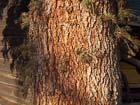
Bark on the right-hand tree above [C.J. Earle, 2012.09.26].
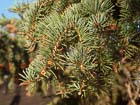
Foliage, twigs, and pollen cones from a tree in habitat [C.J. Earle, 2012.09.26].

Mature cone, San Juan Mountains, Colorado [Jeff Bisbee, 2014.09].
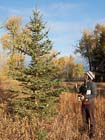
Naturally regenerated sapling [C.J. Earle, 2012.09.26].
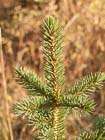
Growing tip on a sapling [C.J. Earle, 2012.09.26].
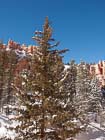
Tree in habitat at Bryce Canyon National Park, UT; most cones borne on upper crown [C.J. Earle, 2013.12.06].
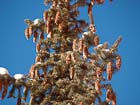
Cones on the tree above [C.J. Earle, 2013.12.06].
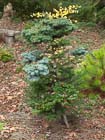
An ornamental with 3 cultivars grafted onto a single stem [C.J. Earle, 2011.10.15].
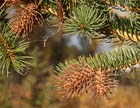
Picea pungens is subject to attack by spruce budworm [C.J. Earle, 2012.09.26].
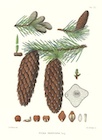
Illustration from Sargent (1898).

Picea pungens
Engelmann 1879
Common names
Blue spruce, Colorado blue spruce, white spruce, silver spruce, Parry spruce (Peattie 1950), épinette bleue (Canadian French), pino real (Spanish) (Taylor 1993).
Taxonomic notes
Syn: Picea parryana Sargent. Limited hybridization occurs between Picea pungens and P. engelmannii (Taylor 1993).
Description
Trees to 50 m tall and 150 cm dbh; "crown broadly conic. Bark gray-brown. Branches slightly to strongly drooping; twigs not pendent, stout, yellow-brown, usually glabrous. Buds dark orange-brown, 6-12 mm, apex rounded to acute. Leaves 1.6-3 cm, 4-angled in cross section, rigid, blue-green, bearing stomates on all surfaces, apex spine-tipped. Pollen cones red, in whorls of 3-5 at proximal end of new shoots, borne primarily in upper crown. Seed cones also borne in upper crown, pale green or red ripening pale buff, (5)6-11(12) cm; scales elliptic to diamond-shaped, widest below middle, 15-22 × 10-15 mm, rather stiff [at the base, with a thin flexible apex], margin at apex erose, apex extending 8-10 mm beyond seed-wing impression. 2n=24&. Cones mature in August, seed shed from September into winter. Epicormic branches are common, but vegetative reproduction has not been reported (Burns and Honkala 1990, Taylor 1993).
Distribution and Ecology
USA: Idaho, Wyoming, Utah, Colorado, New Mexico and Arizona in the montane zone at elevations varying from 1830-2740 m in the northern range of the species, to 2130-3050 m in southern areas. Climate is cool and summer-wet, with mean winter minima of -11.1° to 8.9° C and mean summer maxima of 21.1° to 22.2° C. Average annual precipitation varies from 460 to 610 mm, with 50% of annual precipitation falling during the growing season. It is the most drought-tolerant species of Picea in North America (Burns and Honkala 1990). See also Thompson et al. (1999). Hardy to Zone 3 (cold hardiness limit between -39.9°C and -34.4°C) (Bannister and Neuner 2001).
Distribution data from USGS (1999). Points plotted as tree icons represent isolated or approximate locations.
Picea pungens is the principal species in the Blue Spruce forest cover type and is a minor associate in the Engelmann Spruce-Subalpine Fir (Picea engelmannii-Abies lasiocarpa), Interior Douglas-Fir (Pseudotsuga menziesii subsp. glauca), Cottonwood-Willow (Populus-Salix), and Interior Ponderosa Pine (Pinus ponderosa) cover types. On mesic sites its most common conifer associates are Pseudotsuga menziesii subsp. glauca, Pinus ponderosa subsp. scopulorum, and Abies concolor, but on streamside sites it is often the only coniferous species present. In general it dominates habitats that are too warm for Picea engelmannii or Abies lasiocarpa, and wetter than is typical for Pinus ponderosa. Its shade tolerance is comparable to that of Pseudotsuga menziesii, and it is less shade tolerant than any of the other species of Abies or Picea with which it occurs (Burns and Honkala 1990).
Principal pests afflicting P. pungens include the spruce seed chalcid (Megastigmus piceae), the spruce seed moth (Laspeyresia youngana), the cone cochylid (Henricus fuscodorsana), and the spruce coneworm (Dioryctria reniculelloides). None of these insects are responsible for mortality that substantially affects the species at the population scale. A variety of other insects may afflict living or recently dead trees and are of less consequence for most trees. A variety of diseases also attack seedlings, leaves, stems, and roots. Phytophthora cinnamomi kills seedlings. Three species of Chrysomyxa cause needle rusts. Chrysomyxa arctostaphyli causes the perennial yellow witches' broom on blue spruce branches; Arctostaphylos uva-ursi hosts one stage of the fungus. Armillaria mellea and Inonotus tomentosus both cause root rot, and Phellinus pini, Fomitopsis pinicola, Climacocystis borealis, and Polyporus caesius are common heart rots. Western spruce dwarf mistletoe (Arceuthobium microcarpum) is also common and may result in growth reductions and mortality (Burns and Honkala 1990).
Remarkable Specimens
The largest is height 37 m, dbh 150 cm, crown spread 11 m, located in Ashley National Forest, Utah (American Forests 1996). The tallest known trees all grow in the San Juan Mountains of Colorado. The current height record, 54.9 m, belongs to the Protect Hermosa tree, which grows in the Hermosa Creek area, and was discovered on 2014.08.14 by Matt Markworth. This tree has a dbh of 104 cm (Markworth 2014, 2015).
Maximum ages of 600 years are reported (Burns and Honkala 1990), without supporting data.
Ethnobotany
Thanks to its cold hardiness and glaucous foliage, which assumes a lurid blue hue in some cultivars, this is among the most widely planted ornamental spruces; at least 38 named cultivars are available and the species is widely planted throughout the temperate zones. It is also prized as a Christmas tree, and is widely grown for this purpose in the northeastern U.S. (Burns and Honkala 1990).
Observations
Some of the tallest trees grow in Wolf Creek Campground below Wolf Creek Pass, near Pagosa Springs, Colorado; the whole area is thick with spectacular spruces, as are most riparian areas in the San Juan Mountains (Robert Van Pelt e-mail 2004.02.04).
This species is widely distributed on the floor of Jackson Hole in Grand Teton National Park, particularly in riparian forests along the Snake River. Nearby, it seamlessly blends in with the ornamental cultivars of the same species that are planted on the lots of trophy homes around Jackson. It would be interesting to hunt out a few hybrids and see how they are doing.
Remarks
The epithet pungens refers to the stiff, sharp foliage.
Colorado blue spruce is the state tree of Colorado; blue spruce is the state tree of Utah (Taylor 1993). Three times (as of 2017) it has served as the U.S. Capitol Christmas tree.
Citations
American Forests 1996. The 1996-1997 National Register of Big Trees. Washington, DC: American Forests.
Engelmann, G. 1879. The American spruces. Gardener's Chronicle 11:334.
Markworth, Matt. 2014.08.14. NTS Does It Again - New Colorado Height Champion. www.ents-bbs.org/viewtopic.php?f=70&t=6510#p29693, accessed 2014.08.16.
Markworth, Matt. 2015.06.21. Colorado's Tallest Known Tree Reaches 180'. Microadventures in Dendromorphometry. https://microadventuresindendromorphometry.wordpress.com/2015/06/21/colorados-tallest-known-tree-reaches-180, accessed 2015.06.24, now defunct.
See also
Elwes and Henry 1906-1913 at the Biodiversity Heritage Library. This series of volumes, privately printed, provides some of the most engaging descriptions of conifers ever published. Although they only treat species cultivated in the U.K. and Ireland, and the taxonomy is a bit dated, still these accounts are thorough, treating such topics as species description, range, varieties, exceptionally old or tall specimens, remarkable trees, and cultivation. Despite being over a century old, they are generally accurate, and are illustrated with some remarkable photographs and lithographs.
FEIS database.
Lanner (1983).
Sargent (1898) provides an exceptionally detailed description of this species, with an excellent illustration.












